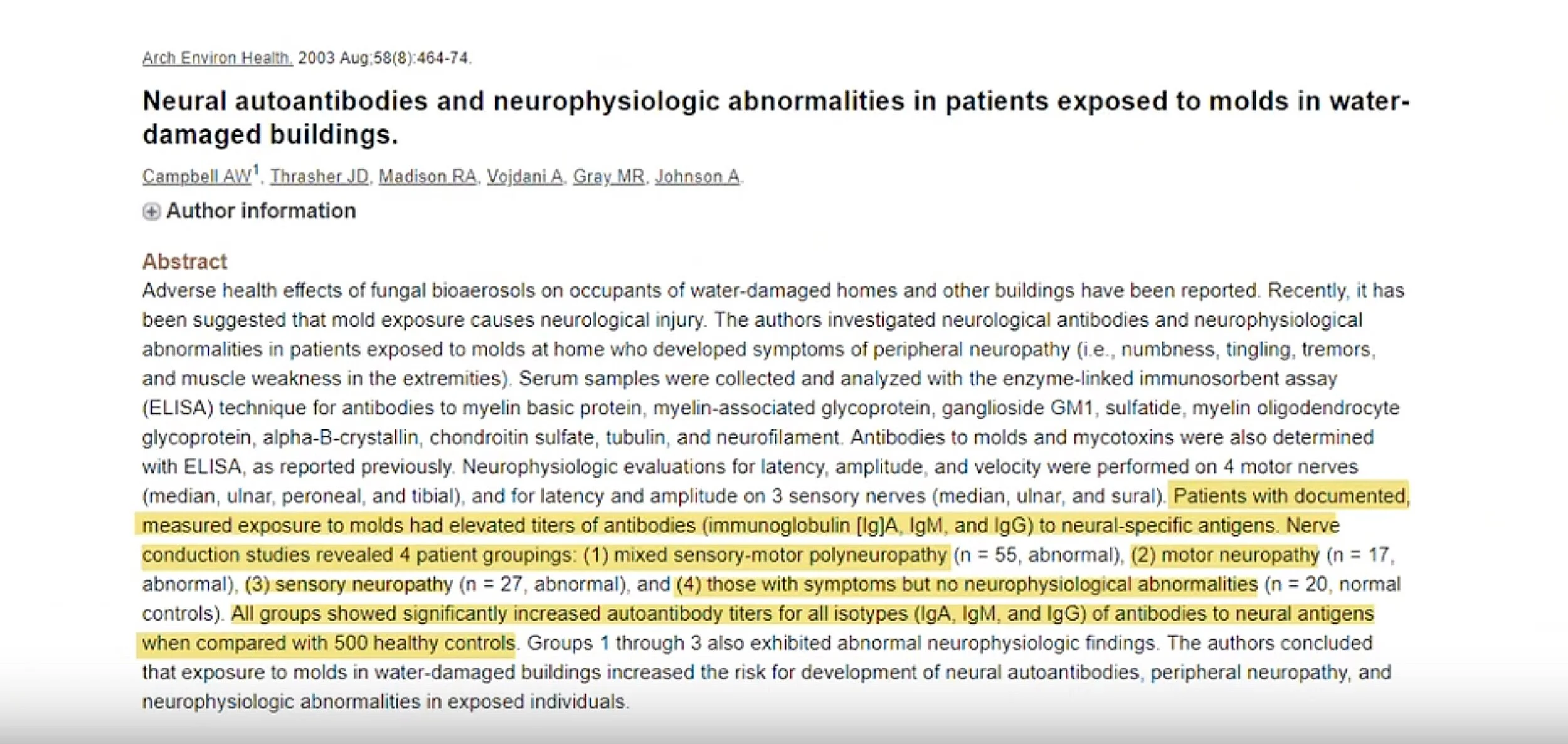Mold and it's contribution to PANS/PANDAS
Our journey to recovery from Autism and PANDAS would not have been complete without addressing mold. Although we saw healing progress for years, especially with the Autism symptoms, it was as if our healing was stuck, preventing us from reaching the finish line with PANDAS. There were lingering symptoms that would wax and wane, but most obvious to us were the ticks. They just wouldn’t completely disappear, which meant his immune system was still on alert. And quite honestly, three out of the four of us continued to experience health instability in a variety of ways.
Our mold ordeal spanned a number of years and five remediation projects, yes five! Why did it require so much time and effort? Well for one, it’s not cheap and two, each project was isolated to certain areas of the house, some of which were not related to the others. We were just lucky enough to live in what I used to call, the perforated house!
Our home was built at a time when new construction was booming in our area. Houses were being slapped up left and right and with that came shoddy workmanship! We joke that now our home is bullet proof because of all the remediation repairs! So if there is a benefit to staying in your remediated home, it’s that you control the outcome and your home can truly become your safe place when you take care of each area of concern methodically and properly. This takes careful consideration of the situation and the remediation company techniques. I would caution anyone taking on mold remediation to educate themselves FIRST, then make sure you know exactly what the remediation company plans to do, step by step. I drove the entire process for each remediation, including firing 3 companies who didn’t meet my expectations. When it comes to your family’s health, don’t take any risks, because remediation done wrong can make your situation worse, much worse! For some, they can’t even remain in their remediated homes and I contribute that directly to the remediation process.
So let’s get right to it and talk about this connection between mold and PANS/PANDAS.
The first question we must ask is does mold cause or contribute to autoimmune disease? Yes. It does. Let me break this down for you…
5% of the population experiences mold allergy
25% of the population has a genetic mutation that prevents mold toxin elimination
Mold sensitivity
Mycotoxins
As you can see, there is a variety of ways a person can react to mold. A person can have one or more reactions to mold and it’s mycotoxins. It’s possible for people in the same household to have no observable reactions to mold, while others have every reaction listed above. This is a completely individual, case by case situation so please don’t write off mold just because everyone isn’t having a noticeable reaction.
Mold allergy
In the 5% who experience mold allergy, their response is quite similar to sinusitis or other allergic reactions. They might have chronic sinusitis with frequent upper respiratory infections leading to bronchitis and even pneumonia, asthma, ear infections, and coughing. Living in a humid environment provides the prime conditions for the sinuses to house chronic mold and yeast. Mold and yeast are the same thing, they are both a fungus.
Genetic predisposition to mold toxin accumulation
In the 25% or so of the population that has inherited a genetic mutation in the HLA-DR gene, they do not create antibodies to deactivate and remove mold toxins, therefore they develop excessive accumulation of these harmful neurotoxins. These people will continue to deteriorate when exposed to mold and their situation can actually become quite dire with continued exposure, because the toxins are not being effectively eliminated from the body. Upwards of 90% of those with addiction and/or chronic illnesses are found to have this genetic mutation. People with mycotoxin accumulation require help detoxing.
Mold sensitivity
It is possible to experience non-allergic reactions to mold which would fall into the category of a mold sensitivity. These people will often experience multiple chemical sensitivities and mast cell activation as a result of the immune system suppression from the mold mycotoxins. Clearly a person with mold sensitivity AND genetic HLA-DR mutation will have a more severe response to mold.
Mycotoxins
Mycotoxins are essentially mold poop! They are a chemical byproduct of the fungal spore lifecycle. They are gaseous and they spread to the environment around the mold, sticking to everything they come into contact with. Mycotoxins cannot be washed off of surfaces (although there are a few potential ways to denature them) and mycotoxins are estimated to have a half-life of 90+ years. That means it will take 90+ years for only half of the mycotoxins to decompose! Considering they don’t wash off of surfaces, remediation must take this into consideration. This is why I recommend removal of mold damaged (and it’s surrounding) materials rather than “treatment” that leaves them behind. Because mycotoxins are neurotoxic chemicals, they are highly poisonous to humans which is why there is a large effort to reduce them in the foods we eat. Just do a search on grains and mycotoxins, there is a ton there! Mycotoxins are similar to VOCs (volatile organic compounds). They cause immune suppression, kidney damage and cancer.
Mold toxins are lipophilic meaning their molecular structure consists of fatty acid molecules. For this reason, mold toxins migrate to and deposit in the brain – the brain is the “fattiest” organ, consisting 60% fat. -Cheryl Ciecko
Mold and autoimmunity
This is where the connection between mold and PANS/PANDAS will begin to make more sense. Studies have proven a definitive link between mold toxicity and immune response.
This study confirms the connection between mold mycotoxins and elevated titer antibodies to neural-specific antigens resulting in motor neuropathy as well as sensory neuropathy. In PANS/PANDAS, the immune system has become conditioned to attack the tissue of the basal ganglia in the brain (neural-specific antigens) resulting in motor dysfunction. In our son, motor dysfunction manifested as a variety of motor ticks and delays.
Mold exposure can trigger an immune response that causes the body to attack nerve tissue. -Dr. Osborne of the Gluten-free Society
In this next study, we are looking at how mycotoxins are linked to inflammatory and immune system responses.
Mold can cause nerve damage, inflammatory reactions, autoimmune diseases and cancer.
While PANS/PANDAS can initially be triggered by anything that activates a chronic immune system response within the brain (meaning the pathogen or toxin crosses the blood brain barrier, like mold, strep, gluten, viruses and other microbes), a flare can also be triggered by other contributors like stress, pollen and foods. Once the autoimmune cascade has begun, the triggers can be as varied as the individual symptoms associated with the condition.
Our older son tested positive for elevated strep titers as well as elevated strep in stool samples, meaning it was also growing in his gut, but his reaction to mold was severe, maybe even more so than strep. His most severe flare was when he was exposed to mold both at school and in our home, all at the same time. Pulling him out of school (we now homeschool) and remediating our home resulted in complete resolution of the remaining symptoms. I want to be careful about oversimplifying this though…I don’t mean to make it sound like ALL we did was remove the mold, because the whole truth involves a lot of work to rebalance his immune system, remove toxins and improve gut flora, but what I am saying is that without the elimination of mold in his environment, we wouldn’t have been as successful at recovering him. When the gut flora is tipped towards pathogenic, because of a deficiency in beneficial bacteria, the body won’t be equipped to mount a proper response to immune activation so even if you don’t have the dreaded HLA-DR genetic mutation, healing the gut is a huge piece of this puzzle.
The good news is once you have eliminated the mold source and begun healing from mold toxicity, your future reactions to mold exposure should be less severe due to improved immune function in general. A person with sensitivities to mold will always have to be diligent with mold avoidance, especially if they carry the HLA-DR mutation, but recovery from subsequent short-term exposures will come easier and faster.
After our own was in PANDAS remission and he was symptom-free, we bought a small beach bungalow near my family at the coast. We noticed a minor regression in him the first summer we spent there, but thought it might have just been the excitement of the whole experience, because the regression was minor and he returned to baseline after we got back home. The second and third summers, the regressions were a bit more concerning and three of us had significant mood imbalances. This is when we realized we were most likely dealing with mold. Testing confirmed my fears and we went on to clean up the environment using environmental probiotics and a HiTech, which resulted in much lower mold test results within three weeks. With those reduced mold scores, we also saw all of our symptoms dissolve in that same timeframe. This was an eye-opening experience for us. Not only did it confirm our suspicions about mold causing PANDAS, but it also confirmed that with his stronger immune system, he was able to bounce right back to his healthier baseline.
When the toxic exposures that depress immune function are chronic, the body is in a constant state of fight or flight, which effects growth, development, hormone production and response to stimuli. Mold is a block to healing, so even if you are doing everything else right, if there is an excessive exposure to mold (and remember each person’s exposure limit will be different) it may be the reason you aren’t crossing the finish line.
If you would like to learn more about prevention, remediation and testing for biotoxin illness, you can find links for products and testing here.
My experience with mold spans decades. I started this website to help families dig deeper and find solutions. For more personalized assistance with your investigation into mold, consider joining my coached community.
Resources:
https://www.ncbi.nlm.nih.gov/pubmed/15259425
https://www.ncbi.nlm.nih.gov/pubmed/26010737
https://www.glutenfreesociety.org



